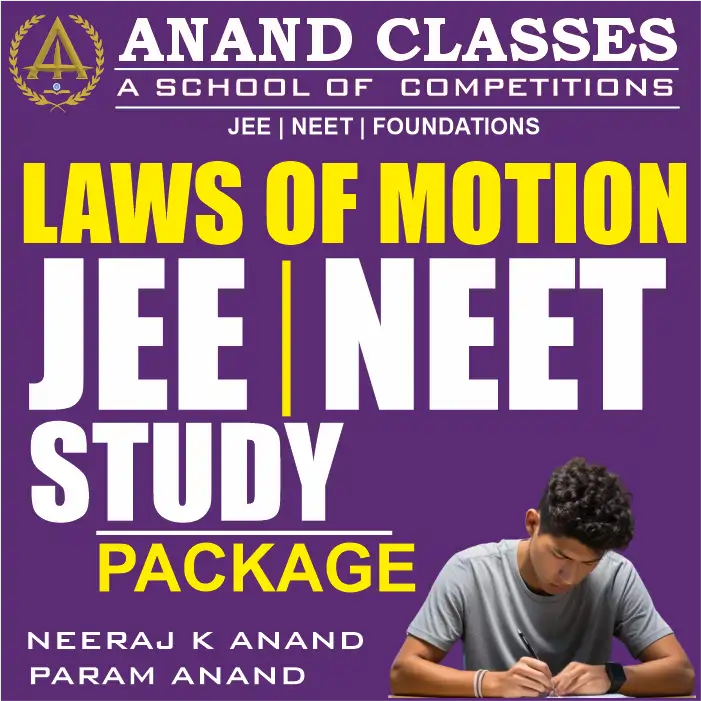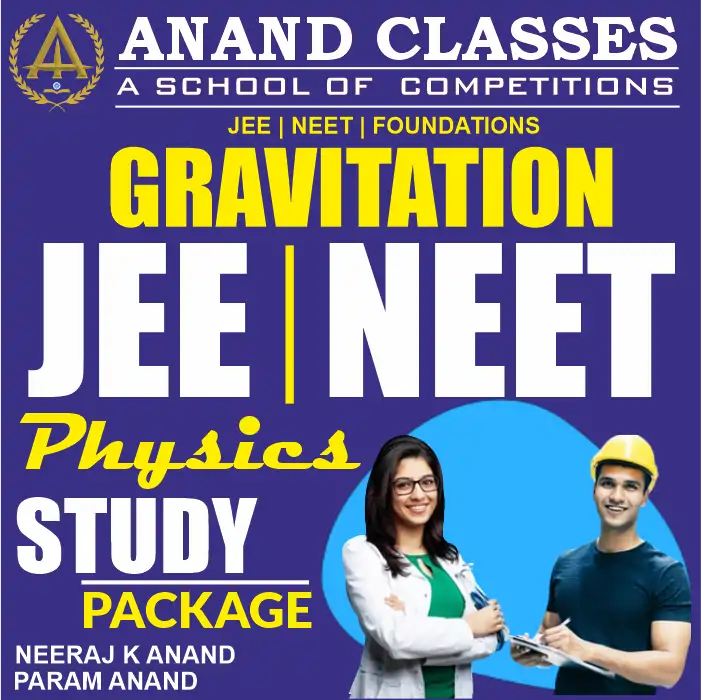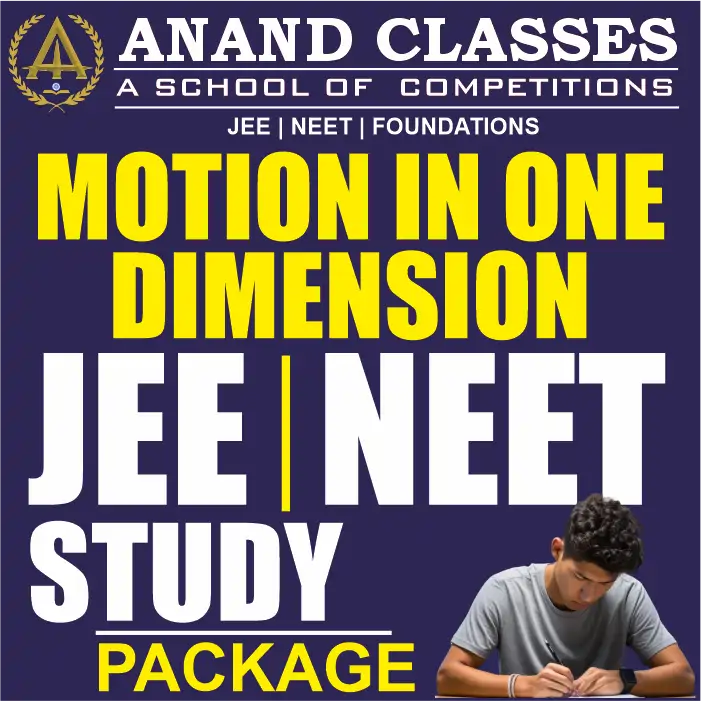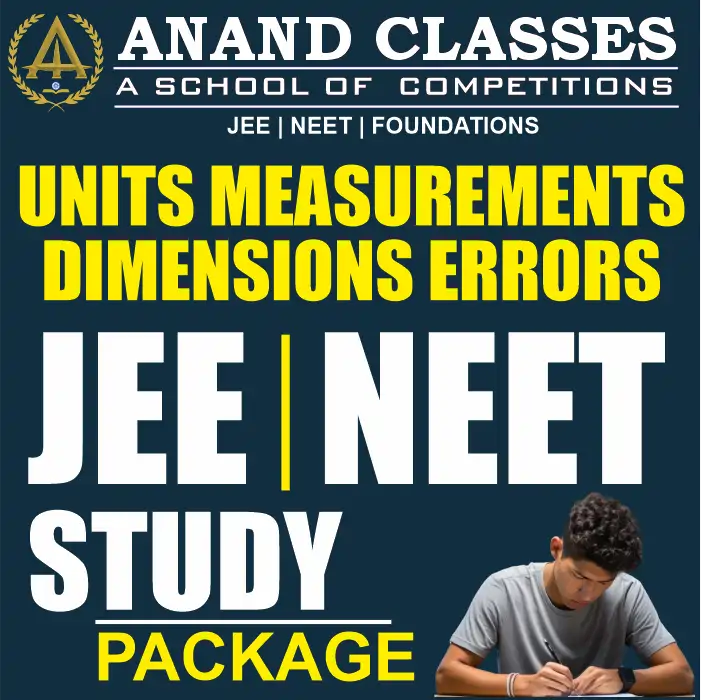Laws of Motion Notes With JEE NEET MCQS Physics Class 11 CBSE Study Material Full Chapter Download pdf-Anand Classes
What is Inertia?
The property of an object by virtue of which it cannot change its state of uniform motion along a straight line or rest on its own is called as inertia. It is the measure of the mass of a body. There are 3 types of inertia.
- Inertia of rest
- Inertia of motion
- Inertia of direction
What is Force?
A force is a push or pull upon an object resulting from the object’s interaction with another object. Force can be categorized into two types;
- Constant Force
- Action at a distance force
What are Newton’s Laws of Motion?
- First Law: “A body continues in its state of rest or of uniform motion in a straight line unless it is compelled by some external force to change that state.”
- Second Law: “The net force produced by an object is directly proportional to the magnitude of the net force and takes place in the direction of the force.”
- Third Law: “To every action, there is an equal and opposite reaction.”Important Questions
- Aristotle observed that the force that is mandatory to keep an object in uniform motion is wrong. He found that force is required only to keep the opposing force of friction.
- Galileo came to a conclusion about the law of inertia with the help of simple observations on the motion of objects on the inclined planes. The statement of Newton’s first law is re-framed as “Everybody continues to be in its state of rest or of uniform motion until and unless an external force acts on it.”
- Momentum (p ) of a body is the product of its mass (m) and velocity (v) :p = mv
Newton’s First Law of Motion
Newton’s First Law of Motion, also known as the Law of Inertia, is a fundamental principle that describes the behaviour of objects in the absence of external influences. The term “Law of Inertia” emphasizes the concept of inertia, which refers to the property of massive objects to resist changes in their state of motion. This idea stems from the observation that objects naturally maintain their current state of rest or motion, resisting any changes unless acted upon by an external force.
By naming the first law of motion the “Law of Inertia,” Newton highlighted this inherent property of objects and laid the groundwork for understanding how forces can cause changes in motion. Newton’s first law of motion states that objects persist in their current state of motion unless compelled to do otherwise by an external force. Whether an object is at rest or in uniform motion, it will continue in that state unless a net external force acts upon it.
One crucial insight provided by Newton’s First Law is that the object will maintain a constant velocity in the absence of a net force resulting from unbalanced forces acting on an object. If the object is already in motion, it will continue moving at the same speed and direction. Likewise, if the object is at rest, it will remain stationary. However, introducing an additional external force will cause the object’s velocity to change, responding to the magnitude and direction of the force applied.
Understanding Newton’s First Law of Motion sets the stage for a deeper exploration of the subsequent laws that govern the complexities of motion. By comprehending this fundamental principle, we gain crucial insights into how objects behave independently and how external forces influence their motion. The first law of motion provides a strong foundation for further understanding the dynamics and behaviour of objects in the physical world.
Newton’s Second Law of Motion
This section will explore Newton’s Second Law of Motion, which provides a deeper understanding of how bodies respond to external forces.
The second law of motion describes the relationship between the force acting on a body and the resulting acceleration. According to Newton’s second law, the force acting on an object is equal to the product of its mass and acceleration.
Mathematically, we express Newton’s Second Law as follows:
Here, F represents the force, m is the object’s mass and a is the acceleration produced. This equation reveals that the acceleration of an object is directly proportional to the magnitude of the net force applied in the same direction as the force and inversely proportional to the object’s mass.
By understanding Newton’s Second Law, we can determine how much an object will accelerate when subjected to a specific net force. The equation highlights the intricate relationship between force, mass, and acceleration, providing a quantitative framework for analysing the dynamics of objects in motion.
In the second law equation, a proportionality constant is represented by the letter “k.” When using the SI unit system, this constant is equal to 1. Therefore, the final expression simplifies to:
With this law, we gain a quantitative understanding of how external forces impact the motion of objects based on their mass and the resulting acceleration they experience.
Newton’s Third Law of Motion
Newton’s Third Law of Motion states that for every action, there is an equal and opposite reaction. When two bodies interact, they apply forces on each other that are equal in magnitude and opposite in direction. This law highlights the concept that forces always occur in pairs.
To illustrate this principle, consider the example of a book resting on a table. As the book applies a downward force equal to its weight on the table, the table, in turn, exerts an equal and opposite force on the book. This occurs because the book slightly deforms the table’s surface, causing the table to push back on the book, much like a compressed spring releasing its energy.
This third law of motion has profound implications, including conserving momentum. Momentum is a property of moving objects determined by an object’s mass and velocity. According to Newton’s third law, the total momentum of an isolated system remains constant. This means that in any interaction, the total momentum before and after the interaction remains the same, regardless of the forces involved.
Laws of Motion Summary
This section presents a visual summary of Newton’s Laws of Motion in the form of a flowchart. The flowchart provides an easy and digestible format to remember the key principles underlying the three laws of motion.
The flowchart highlights the three laws of motion established by Sir Isaac Newton:
- Newton’s First Law of Motion: The law of inertia states that an object at rest will remain at rest, and an object in motion will continue moving with a constant velocity, unless acted upon by an external force.
- Newton’s Second Law of Motion: This law relates the force acting on an object to its mass and acceleration. The force is equal to the product of mass and acceleration, where acceleration is the rate of change of velocity.
- Newton’s Third Law of Motion: The law of action and reaction states that for every action, there is an equal and opposite reaction. When one body exerts a force on another body, the second body simultaneously exerts a force of the same magnitude but in the opposite direction on the first body.
Frequently Asked Questions on CBSE Class 11 Physics Notes Laws of Motion
What is inertia?
Inertia is a property of matter by which it remains at rest or in motion in the same straight line unless acted upon by some external force.
What are some of the uses of force in real life?
1. Weight things 2. A force of bat on a ball
Why is the third law of motion important?
This law is important in analysing problems of static equilibrium, where all forces are balanced.
Who discovered the three laws of motion?
Why are the laws of motion important?
What are Newton’s laws of motion all about?
What is the difference between Newton’s laws of motion and Kepler’s laws of motion?
What are some daily life examples of Newton’s 1st, 2nd and 3rd laws of motion?
- The motion of a ball falling through the atmosphere or a model rocket being launched up into the atmosphere are both excellent examples of Newton’s 1st law.
- Riding a bicycle is an excellent example of Newton’s 2nd law. In this example, the bicycle is the mass. The leg muscles pushing on the pedals of the bicycle is the force.
- You hit a wall with a certain amount of force, and the wall returns that same amount of force. This is an example of Newton’s 3rd law.


































